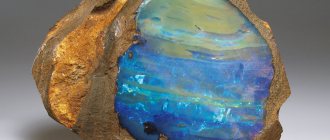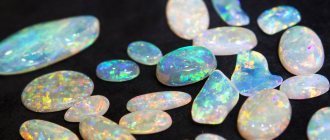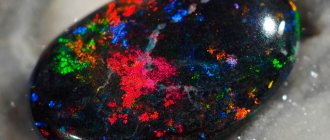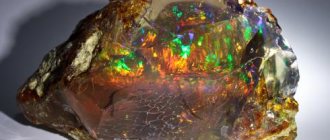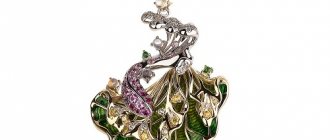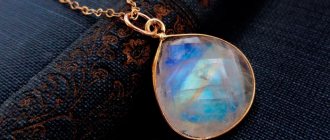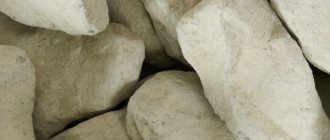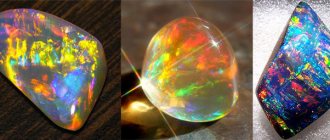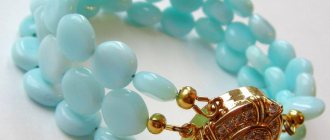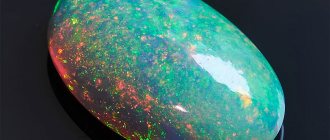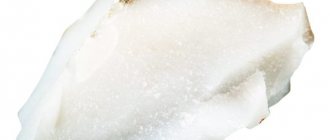Opal is a stone with many faces.
It comes in a variety of colors, from completely transparent to black as the night sky. All its jewelry varieties are distinguished by a wonderful play of light, incomparable to any other mineral. They say that it is impossible to take your eyes off it - the stone is so beautiful. There were legends about the properties of opal. Nowadays it is still used by jewelers, and not only them. With the help of the mineral, lithotherapists treat diseases, and magicians, as in the old days, try to penetrate the deep secrets of the universe. But in order for the stone to help you, you need to be among those to whom it suits their character and zodiac sign. Well, first things first.
Historical reference
Opal was known to ancient peoples; beautiful and frightening legends were created about it.
Opal is mentioned in myths and traditions on all continents.
- The ancient Greeks associated it with the victory of Zeus over the Titans, after which the supreme god burst into tears of happiness. The tears that fell to the ground became rainbow opals. It was believed that the Zeus stone made the owner a fortune teller.
- Australian aborigines are confident that sparkling stones, called “desert fire,” remained on the site of the traces of the Creator of the World.
- Arabic legends claim that opals are the children of lightning, brought to earth. The stone can protect from thunderstorms or bad weather, and make a person invisible.
- In India, opals are considered parts of the body of the rainbow goddess. Fleeing from annoying gentlemen, she fell, crumbling onto beautiful stones.
For centuries, opal's purpose has been to bring good luck. But the fall from grace is ambiguous. To the Romans it represented hope and purity, but black opal was Caligula's favorite. This friendship became fatal for the emperor. Scandinavian sagas say that the opal stone was forged by the blacksmith god from children's eyes. The early Middle Ages is full of descriptions of dark rituals with opal in the leading role. Opal powder was a poison that was added to food.
The English King Edward VII, in order to protect himself from the influence of the gem, ordered the opals to be removed from the crown. Napoleon's wife Josephine laughed at this - and in vain. When the Burning Troy pebble moved into their home, the couple divorced. Then they began to say that the mineral allegedly self-destructed, dissolving into the air. This is possible, given the properties of natural opal. Clients refused the stones, and jewelers had no choice but to throw them away.
Origin
A fragment of the jaw of the ancient mammal Kollikodon ritchiei, which became opal during the process of fossilization. It
has been scientifically proven that opals are petrified trees and skeletons of small animals. They formed in the ground or craters of volcanoes.
Forms of opal release: cluster-shaped or kidney-shaped aggregates of amorphous silica, cracks. It usually occurs among limonites, sandstones, rhyolites and basalts.
The origin is sedimentary, supergene or low-temperature hydrothermal. It occurs in the form of veins, filling cracks in the host rocks.
The rocks diatomite, tripolite and opoka are made up of scattered small particles of opal.
Opal forms various kinds of sintered forms or nodules, often forms pseudomorphs on various minerals, and also impregnates various animal and plant remains, forming fossils. Sometimes found in the form of earthy masses or fine powder.
Physical and chemical properties
Opal is amorphous silica, devoid of a crystal lattice. Semi-precious jewelry stone.
The color of opal varies, but all types have a common characteristic: pearlescent luster. The effect in which the glow comes from inside the stone and scatters across the surface is named after the stone - opalescence. Applies to other precious minerals.
Opals can be transparent or translucent. This determines the percentage of water in the stone: the more, the more transparent the gem. For the noble ones - strictly 6-10%.
| Color | Colorless, white, yellow, red, brown, blue |
| Stroke color | white |
| origin of name | from the ancient Indian upala - precious stone |
| Opening year | known since ancient times |
| IMA status | valid, first described before 1959 (before IMA) |
| Chemical formula | SiO2+H2O |
| Shine | glassy, greasy, waxy, pearlescent, dull |
| Transparency | transparent, translucent, opaque |
| Cleavage | not visible |
| Kink | conchoidal, uneven |
| Hardness | 5,5, 6, 6,5 |
| Thermal properties | Under the blowpipe it cracks a lot, but does not melt. |
| Luminescence | yellow-green (uranyl) |
| Strunz (8th edition) | 4/D.01-80 |
| Hey's CIM Ref. | 7.8.8 |
| Dana (8th edition) | 75.2.1.1 |
| Molecular weight | 87.11 |
| Density (measured) | 1.9 — 2.3 |
| Pleochroism | does not pleochroate |
| Refractive indices | nα = 1.400 – 1.460 |
| Optical relief | moderate |
| Selection form | kidney-shaped, collomorphic cluster-shaped, stalactite sinter aggregates, plaques, concretions, geodes, solid masses, pseudomorphs of organic remains and some minerals |
| Classes on taxonomy of the USSR | Oxides |
| IMA classes | Oxides |
| singonia | amorphous |
| Fragility | Yes |
Colors and varieties
Depending on the properties: color, shine, transparency, hardness, impurities, a fairly significant number of varieties of opals are distinguished.
Opals formed from the silica of weathering silicate rocks, filling cracks and voids in them or penetrating into their mass, are “impure.” These include:
- semi-opal, cloudy, with a greasy sheen, white, gray, yellow, red and brown;
- opal jasper, which is colored red or brown with an admixture of a significant amount of iron oxides.
Opal Jasper
- Wood opal – formed when opal replaces wood residues, preserving the texture of wood (petrified wood).
Wood opal
- Siliceous tuff is a porous, spongy rock formed from hot springs.
Siliceous tuff
- Tripoli (polishing slate) are earthy, loose deposits of microscopic organisms, mainly diatoms.
Trepel
- Noble opal is distinguished by a beautiful play of colors. The color is mostly milky white or yellowish, blue and even black. Translucent or translucent. Refers to precious stones.
Precious opal
- Ordinary opal does not have a play of colors. Transparency to varying degrees. Sometimes colorless, but mostly painted in various dim colors. Beautiful specimens are polished and considered semi-precious stones.
Common opal Other types of opals:
- Fire Opal - Translucent to translucent stones, mostly with colors ranging from hyacinth red to wine yellow, almost red, often without any play. Variations with opalescence are mined in Mexico.
Fire opal
- Black opal is an opal with a dark, not necessarily black, base color, the most expensive variety of precious opals (in particular, Australian black opals).
Black opal
- Boulder (English boulder - cobblestone, boulder) is a type of opal in the form of a layer in the rock, most often ferruginous, but there are also matrix boulders in rhyolite and basalt rocks. The best varieties of boulders, jowa and koroite, are mined in Australia.
Boulder opal
- Wax opal is waxy yellow in color.
Wax opal
- Hyalite is water-transparent, forms grape-shaped crusts on various rocks; sometimes covered with mosses and lichens.
Opal Hyalite
- Hydrophane, water opal, is porous; when saturated with water, it becomes translucent and reveals a beautiful play of colors.
Hydrophane water opal
- Girazol (girasol, girasol) is transparent, almost colorless, with an iridescent bluish tint, usually on a pale milky background.
Opal Girasol
- Irisopal is colorless or slightly brownish with a single-color tint, mined in Mexico.
Irisopal
- Cacholong, pearl opal, semi-opal is a milky white stone that is an opaque mixture of quartz, chalcedony and porcelain opal.
Cacholong
- Peruvian (blue) opal - pink, blue and even bluish stones are found in Peru. They are not multi-colored.
Blue Peruvian opal
- Prazopal, chrysopal is an opaque apple-green stone.
Chrysopal
Physico-chemical characteristics of girasol
Like all other varieties of opals, jirasol is a quartz stone. It consists of a silica hydrogel with air particles and water droplets inside. Girazole is painted white or shades of blue. The stone is characterized by opalescence - a glow in the light with reddish and blue sparks.
Place of Birth
Opal
Opal is often found in thin layers or flat lenses, large pieces are rare. It is found on all continents, but Australian deposits account for, according to some statements, about 97% of all world production. Of these, 90% are called “light opals” or white crystalline opals.
Most Australian opals are mined in Coober Pedy in South Australia. The boulder type is mined in the state of Queensland. One of the largest mines producing this type of mining is Jundah. In the state of New South Wales, in the area of the town of Lightning Ridge, another opal with a predominant black color is mined (with a play of colors from dark gray to black-blue). This type is considered the rarest, as black opal accounts for only about 5% of the total opal mined in Australia. Opal is considered the national stone of Australia.
In addition to Australia, Ethiopia is a major exporter of opals. Most of the precious opals are mined in Australia, Mexico, Brazil, Guatemala, Honduras, Japan, Slovakia, the USA (Nevada), with minor occurrences in Russia (Kamchatka) and Ukraine.
Ordinary and fire opals are often found in Mexico (states of Hidalgo (state) and Queretaro), Brazil, Guatemala, Honduras, USA, Turkey, Kazakhstan.
This is interesting!
In late 2008, NASA announced that it had discovered opals on Mars.
Types of opals
It is difficult to count the varieties of opal; such a riot of color and patterns is no longer found in nature. Descriptions of different gems can be found in ancient mythology; special properties were attributed to each specimen.
Varieties of opal species:
- Black is considered the rarest and most expensive, and dark blue and purple opals are also found.
- Fire opal is found in Mexico, the palette ranges from honey-yellow to rich hyacinth shades, and has a subtle pearlescent sheen.
- Varieties of opal include amazing pearl gems, specimens are opaque, there are various inclusions, similar gems are found in Kazakhstan.
- Blue - the description of the stone corresponds to sea blue, the incredibly bright saturated color can be confused with artificial, the peculiarity is the ability to change color from soft blue to dark blue.
- Green opal is the most popular among collectors; it is opaque, similar to jade, but the color scheme is brighter and the patterns are contrasting.
- Whatever shade you can find in the opal family, there are even waxy gems similar to amber.
Video: Living Gemstone
Magical properties of opal
Black opal ring
The magical qualities of opal have been studied by magicians and esotericists. But the influence of the stone is ambiguous; caution is required with it.
The energy of the opal will excite the owner. For active, mercantile pragmatists who live in a strict rhythm, this is a suitable option. People leading a leisurely or measured lifestyle will be “crushed” by the stone. Opal is endowed with strong energy, but it “agrees” to serve only charismatic, talented owners. The rest will be alienated or made unhappy.
In natures with an unstable character, the gem will give rise to suspiciousness, quarrelsomeness or fear.
Creative people understand the meaning of the stone: opal activates and directs the creative process, preventing outside influence.
The magical properties of natural opal are determined by its appearance and color:
- Black. An attribute of sorcerers, strong personalities or passionate natures. Sharpens the mind and analytical thinking. But the magic of opal, especially in gold, activates vices, which is advisable for future owners to take into account. First of all, players and adventurers.
- White. Stone of virtue, talisman of philanthropists, healers, social workers. Supports patience and compassion.
- Fiery. The magical properties of this stone enhance gender traits: in men - confidence, in ladies - femininity and wisdom.
- Blue. Opals ranging from blue to ultramarine bring good luck. Ideal amulets on the way to the goal, helping to gather strength, directing them in the right direction. The stone makes the owner clairvoyant (especially in a dark purple hue). It will remove tension during communication or add confidence.
- Pink. Suitable for people seeking peace or security. Harmonizes the inner mood and love sphere, protects against illnesses or failures. Relieves stress, insomnia or nightmares.
Astrological meaning
This gem fascinates with amazing designs created by nature itself. The stone of inner peace and balance has fallen; worldly problems and passions are alien to it, it helps to separate the true from the unimportant. When choosing jewelry or a talisman with colored minerals, it is worth considering which zodiac signs opal suits according to the horoscope. This is the patron saint of those born in October; its strength corresponds to moderation, diplomacy, and balance in relations with others.
Who opal is suitable for also depends on the goals; it will be an excellent assistant for self-improvement, but is completely useless for pragmatists who want to achieve dishonest career heights.
Astrological properties and who is suitable according to zodiac sign:
- For calm Capricorns, an amulet in the form of a mineral will allow them to believe in themselves, get rid of uncertainty and eternal doubts. Belief in a happy future and hope for achieving goals appear. Self-esteem will improve, representatives of the Earth elements will be less susceptible to stress and anxiety. Opals will help mitigate the characteristic shortcomings of Capricorns - stubbornness will become determination, selfishness will become faith in one's own capabilities, anxiety, fussiness and tediousness will become forecasting the future.
- The zodiac sign Libra is in an eternal search for harmony, symmetry, and balance. This unique gem will help you find your inner balance. For dreamy representatives with changeable moods, opals will help direct energy for creative purposes. It is at the peak of emotional outbursts that the stone absorbs the power of thoughts and words, balancing the extreme points of manifestation of character traits.
- The fire signs of the zodiac will not be able to cope with the power of the stone; the struggle of energies will weaken the temperamental representatives. The chosen jewelry will suppress the leadership abilities of Leo, the passion of Aries, and the determination of Sagittarius. Natural character traits that allow one to achieve success are neutralized by the action of the gem. Internal contradictions will arise between the goals set and the possibilities for their implementation. Use stones to correct your health once, without constantly seeking help.
- Gemini and Aquarius should not expect miraculous changes in life; they can only be worn as decoration. Opals are not suitable as a talisman; they have a neutral effect on these signs.
- Pisces and Scorpios can choose white stones if their activities are aimed at serving people. These are not only doctors, social workers, volunteers, but also politicians who provide targeted assistance.
- Black opals are not recommended for Libra, Aquarius, and Sagittarius. The power of the dark stone draws you into dangerous hobbies; only the strong in spirit can resist the mineral.
Medicinal properties
Opal Girazol ring
Opals can be worn not only as decoration, but also to provide a healing effect on the body.
Lithotherapists claim that opal:
- Increases stress resistance.
- Normalizes the functioning of the nervous system.
- Improves mood, regulates mental activity.
- Improves the functioning of the central nervous system.
- Raises muscle tone, relieves nervous tics, softens the manifestations of chronic cramps.
- Normalizes the activity of the heart muscle, helping to restore the correct heart rhythm.
- Improves the general condition of the eyeballs and vision by normalizing blood flow in the vessels of the eyes.
- Promotes the digestion of food by normalizing gastric peristalsis and increasing blood flow in the collateral perigastric vessels.
- Useful for women because it can facilitate childbirth and limit the growth of body hair.
- Dissolves toxins, cleansing the body.
- Eliminates pain (toothache and headache).
- Helps improve appetite.
- Has a beneficial effect on the kidneys.
- Improves sleep.
- Grants longevity.
Talismans and amulets
Gold ring with white opal
Gold ring with white opal, worn on the index finger of the right hand, is a talisman for people involved in medicine, since this stone gives them the ability to heal the sick, alleviating their suffering.
An opal amulet will ensure success in business if the owner overcomes selfishness or greed.
Taking such a talisman with you on a long trip or on a tourist trip, you can be sure that your exhausted strength will quickly be restored.
A pendant or keychain in silver is a lifeline for melancholic people, suicidal people, and people hovering in a fantasy world. Opal amulets and talismans (figurines, boxes, simply processed stones) will maintain peace in the house and protect the home from natural disasters or robbers.
The natural energy of opal reaches peak values by October.
What does a gem cure?
The East unconditionally gave opal the palm in healing from all diseases. Patients used a ring with a gem; it was supposed to be worn on the index finger of the right hand.
Unverified: there is a belief that opals lose their shine and opalescence before the owner becomes seriously ill.
Now esotericists divide the healing properties of opal according to its type and color:
- Pink gem will help with diseases of the cardiovascular system. Normalizing blood pressure and relieving swelling - these are the “professional” capabilities of the stone.
- Blue opals are responsible for the mental health of the owner. A heavenly-colored opal will help calm your “unhinged” nerves and normalize your emotional state.
- Green gems will help you hear and see better. To do this, massage the line between your eyebrows with a stone at least once a day.
- All noble opals, as lithotherapists say, normalize the functioning of the gastrointestinal tract and improve metabolism. As a result, they will help you lose a few extra pounds.
A gem amulet is useful for older men.
To treat infectious and heart diseases, water infused with opal is used.
It is not advisable to wear opal jewelry all the time.
Do not forget that the stone will not replace a doctor, but will only help in treatment.
Areas of application
Wax opal
Tripel ring was previously used as a material for making dynamite.
Noble opal belongs to precious stones; the best examples are highly valued. The largest opal found near Coober Pedy in 1956 is valued at A$2.5 million. To better display the color play of precious opals, they are given round or oval cabochon shapes or other softly convex shapes, depending on how the raw material allows it.
Mass-produced jewelry often uses opal doublets—polished opal flakes glued to onyx, obsidian, black glass, or regular opal.
If opals are stored in low humidity conditions, loss of moisture may cause them to crack and become cloudy. Therefore, jewelry and jewelry with opals should be worn as often as possible, since the gemstone can take the moisture it needs from the air or the skin of the person who wears it.
Due to the low hardness of opal, when creating jewelry, craftsmen make frames that protect them. Previously, the surface of the opal was covered with oil, then they switched to impregnating the opals with colorless artificial resin.
Currently, synthetic opals are widely produced, including in Russia (in St. Petersburg and Novosibirsk). Imitations and counterfeits of opal are common, mainly when they pass off specially made opalescent glass as it.
The rocks consisting of opal, diatomite, tripolite and opoka, are raw materials for cement, fillers and other building materials.
This is interesting!
The ancient Romans considered opal a stone that brought good luck. In many countries, it is still perceived today as a talisman. In 1829, Walter Scott published the novel Anna von Geyerstein, in which opal brings death to its owner. After the novel was published, the demand for opals fell by half and remained low for the next 20 years. In Russia, the myth of opal as a stone that brings misfortune was perpetuated by I. V. Kireyevsky’s story “Opal” (1830). Opal is the official stone of South Australia and the Australian women's national basketball team, The Opals.
Where is it used?
This stone has been a precious stone for a long time. It has a rich history filled with legends, so the jewelry is highly valuable and has magnificent beauty. Opal is mainly used in jewelry production. Native specimens are cut into cabochons or given an oval shape. Only noble stones are valuable to jewelers all over the world, while ordinary ones cost less and are used less frequently as raw materials for making jewelry.
The hardness of opal does not allow craftsmen to leave the stone exposed in various crafts, so protective frames are often used. Opals are often coated with a special resin to reduce contact with the environment.
There are also synthetic opals on the market, and glass coated with an opalescent composition is also sold as counterfeits of opal.
Products and jewelry made of opal
Jewelry set with opal
It is believed that the shade of the stone should be selected according to the color of the eyes. At the same time, white and black representatives are suitable for all people, regardless of their appearance. Therefore, they are the most in demand.
Silver and gold are used for the frame. It is believed that black minerals cannot be included in a gold frame, as this will make them aggressive towards their wearer. Therefore, they can most often be seen in silver. Gold is often used for green, blue, cyan and yellow stones.
How much an opal costs depends on many characteristics: color, inclusions, size, rarity of the specimen, color play. The price per carat can start from $10 and go up to $5000–6000. A magic stone is not suitable for everyone; if you have doubts about purchasing it, it is better to stick to light-colored gems. And before buying, you should feel the energy of the mineral, hold it in your palms for a few minutes to understand your own sensations.
Patent and common counterfeits
The first patent for the production of synthetic opals was received by researchers Gaskin and Dorre (Australia). At the end of the 18th century, imitation gems began to be produced on a commercial scale in Switzerland. Their prices are several times lower than for natural ones, and it is quite difficult to distinguish a fake. In the last century, with the advent of nanotechnology, methods for creating stones with opalescence appeared.
It is now difficult to distinguish a natural gem from a fake. But you can try:
- A synthetic stone does not provide that magical play of light - the opalescence that occurs precisely in the depths of the gem.
- Imitation is always brighter, catchier, and more vulgar in color.
- Doublets and triplets can be identified using a magnifying glass - it will help identify the joints, seams between the natural opal plate and the base.
Important: painting white opals black and impregnating stones with synthetic resins is considered a fake.
Trade in doublets and triplets is allowed in jewelry stores. They cannot be called real stones, but they are not completely fake.
A doublet is a thin plate of a gem glued to an opaque base.
A triplet consists of three parts. The “lid” is made of transparent quartz, the opal plate and the backing are made of opaque material.
Synthetic opal
Synthetic opal
Artificial opals can be distinguished as a separate type, the production of which has been constantly growing since the beginning of the 20th century. The main types of synthetic stones are:
- Gilson opal was first obtained in 1972 in Switzerland. This is the most expensive artificial type of stone, which is most similar to natural gems, but is distinguished by the complete absence of water and high stability of the material. The formation process of Gilson stones lasts about 18 months.
- Japanese Kyocera opal , obtained on the basis of hydrated silicon oxide, is distinguished by its high aesthetic qualities, therefore the composition of the artificial stone is identical to natural samples. To increase the density and stability of the rock, samples are impregnated with colorless rubber.
- Slocum opal created in 1964 , which is an alloy of sodium-enriched silicon glass and aluminum sparkles that create an iridescent effect.
- In Japan, a plastic imitation has been developed - neo-opal , or pastoral opal.
- In the USA, the production of milky blue opalite - a plastic imitation made of polystyrene, which is coated with acrylic resin, creating the effect of a play of colors inherent in opals. Sometimes samples obtained synthetically are passed off as moonstone.
History of Girasoli
Jirasol is one of the many varieties of opals. But it is so beautiful and expressive that it was separated into a separate subspecies with its own name. Translated from Italian, “girare” is translated as “to rotate”, and “sole” is translated as “sun”. It is associated with the unusual appearance of girasol. Its samples are transparent, blue or white, and in the rays of the sun they sparkle and shimmer with sparkles of red and blue. This iridescence and play of tones is called opalescence. Additionally, jirasols are also known as sun or sky stones. When looking at a specimen of a gem, its origin becomes clear.
How to spot a fake
Pendant with opal stone
Natural opal can be very expensive, especially if it is a noble variety. Fraudsters have invented several ways to counterfeit precious varieties of gems:
- The simplest and cheapest is to imitate a mineral using plastic or glass.
- Selling cheap varieties under the guise of expensive ones. For example, resin stone is passed off as an elite “night stone”.
- Doublets and triplets. A thin plate of a noble variety is glued with one or two plates of an ornamental variety.
- Artificial stones. They tried to grow crystals in the laboratory back in the 19th century. The breakthrough came in 1972. It was then that chemically produced Gilson opals entered the market.
It should be remembered that a plastic fake, like a synthetic opal, does not have the magical and healing properties of the original. Fortunately, it is quite easy to distinguish a fake if you remember the basic properties of the gem.
First of all, you need to pay attention to what the opal stone you are going to buy looks like. A genuine gem is distinguished by “floating” lights. If you look at it from a different angle, they will change their position in the thickness of the crystal. In a laboratory mineral, the sparks are always motionless.
The price of opal can also say a lot. Jewelry with a night or fire gem is unlikely to cost less than a thousand rubles. These are very rare varieties of the mineral, and jewelers and miners value their work quite highly.
Caring for products with opal
This stone is quite fragile and has low strength, so it should only be placed in a very high-quality setting. Any detergent can be destructive to it - it can even dissolve in a highly alkaline environment. That is why it is better to remove jewelry with an opal stone (photo) when taking a bath or washing dishes. It is also undesirable for makeup to come into contact with the opal. It is better to wash heavily soiled items with a soft toothbrush without soap. If necessary, it can be left in water for a while to soak.
This stone is quite fragile and has low strength, so it should only be placed in a very high-quality setting.
When taking a bath or washing dishes, it is better to remove jewelry with opal stones
It is also undesirable for makeup products to come into contact with the opal.
Opal does not tolerate low humidity, so if stored in a dry room, it may darken and even crack. But, if you wear opal jewelry more often, it will absorb precious moisture from the surrounding air or directly from the skin.
Prolonged exposure to the sun or in rooms with high temperatures does not have the best effect on this stone. It must be stored in a dark place in a box with a soft bottom or wrapped in cloth.
It is better to wash heavily soiled items with a soft toothbrush without soap.
If necessary, it can be left in water for a while to soak.
It is worth considering that, together with water, opal can absorb any coloring agents and change color. Therefore, its contact, for example, with ink, juices or even just dirty water is unacceptable.
Advice! To restore shine to a faded opal, you need to give it the opportunity to absorb moisture. To do this, you need to wash it several times or wrap it in a damp cloth for several days.
How to care for stone
Opal is a fragile stone. It needs special care and careful handling. In order for the mineral to retain its beautiful appearance for a long time, follow certain rules:
- Do not allow chemicals or cosmetics to come into contact with the mineral.
- Keep away from moisture (water opal is an exception).
- Remove jewelry before physical activity.
- Clean when dirty with soft brushes or a cloth in soapy water.
- Rinse from time to time from negative energy under running water. After drying, put it to charge with moonlight.
Rules of care
Fragile stones are washed with a soft damp brush and then dried with a napkin. It is not recommended to use household chemicals for cleaning. The blue mineral is afraid of sunlight, so it is worn covered with clothing. Products containing mineral cannot be cleaned with ultrasound. Vibration causes cracks in fragile materials.
When the stones become cloudy, they are immersed in water for 2 hours. Jewelry should be removed during cleaning or sports activities, as minor impacts can cause chips and cracks.
A separate box is allocated for storing opals, since harder crystals can damage them. It is better to use soft fabric covers for decorations. For long-term storage, the products are wrapped in cotton wool, moistened with a few drops of water. Afterwards they are placed in a plastic bag to prevent moisture loss.
If abrasions or scratches appear, you can contact a cutter. The technician will restore the shine and check the fastenings.
Compatibility with other minerals
Jewelry with blue opal
When choosing jewelry with natural stones, you should consider their compatibility, since a natural gem carries certain information that may resonate with the background of other stones. In this case, the owner will experience discomfort.
Contradictions between minerals can provoke sudden mood swings, uncertainty in decision-making and one’s own strengths.
Opals are stones of the water element, so they go well with minerals of the Earth element, and fire and air gems should be worn separately.
The best companions for opals are amethysts, turquoise, lapis lazuli, blue sapphires, onyx, white pearls and labradorite.
You should avoid sets in which opal is combined with agates, garnets, heliotrope, ruby, carnelian, malachite, chalcedony or jasper.
Who suits the name
This natural stone suits a variety of people. People with the following names can count on the help of this stone:
- Anastasia – opal helps women with this name achieve their goals. It can also become a real protective talisman that helps maintain health.
- Ruslan - opal helps to increase the performance of people with this name. It helps to finish things started. The mineral also makes relationships with your beloved more harmonious.
- Anton - the stone helps people with this name achieve success in love affairs and strive to achieve their goals.
- Elena - opal helps such girls achieve love and mutual understanding. For middle-aged women, the stone helps maintain vitality and protects against diseases.
- Vitaly – opal helps people with this name to establish communication with other people, cope with stubbornness and self-confidence, and eliminate the tendency to contradictions. The mineral also successfully copes with increased nervousness and helps to find a path to self-improvement.
- Irina - opal will help eliminate natural temper and emotionality. It also allows you to develop creativity and move through life with optimism.
Opal and zodiac signs
Opal in jewelry
Representatives of fire zodiac signs should acquire white or blue opals. These universal stones are suitable for people born under any zodiac constellation, but for Sagittarius , Leo and Aries they will help smooth out the manifestations of natural deficiencies, enhancing their best qualities, represented by courage, determination and determination.
At the same time, according to the horoscope, Aries should beware of stones that have dark shades, and Sagittarius should prefer blue opals.
Both fire and white gems are suitable for Gemini, Aquarius and Libra White stones will give them calmness, and the shimmer of fiery specimens will add a bit of violence to their character. Aquarians may like dark blue minerals.
For Pisces and Scorpios, stones of blue-blue and red colors will be useful. Their influence will not only strengthen Pisces’ innate intuition, but will also give them peace of mind. Scorpios, who have received protection from negative influences, will be able to concentrate their energy on achieving their goal.
For Cancer, there is nothing better than white opals, although this is the only zodiac sign that is allowed to wear black stones. By enlisting their support, Cancers will be able to overcome their inner experiences and fears, find harmony in personal relationships and improve their financial condition.
Taurus should pay attention to blue gems: they will give their owners patience and tranquility.
Fire opal is ideal for Virgo and Capricorn By saving Virgos from excessive criticality, he will make them much kinder. With its help, Capricorns will get rid of the habit of groundless worries.
Rainbow Stone Astrology
Astrology considers opal to be the birthstone of October.
The patron planet is the Moon, some astrologers are sure that different types of opals are also ruled by Neptune and Pluto.
We recommend: Rose Crystal | PINK TOPAZ
Many astromineralogists are sure that opal is suitable for any zodiac sign. It is important to choose the right type of stone.
- Red and fire opal are suitable for fire signs. This is especially true for Aries and Leo.
- Pisces is ideally compatible with transparent opals.
- Scorpios - your stone is black opal.
- Cancers and Libras can benefit from wearing precious jewelry.
- According to the horoscope, green and black opals are suitable for Taurus and Capricorn.
Recommendation from astromineralogists: wear a ring with an opal on your middle finger, and during the day put the stone on the middle finger of your left hand, then on your right, 2-3 times.
Favorable time to buy
Ring with white opal stone
Opal is a stone that requires special attention. In order for the mineral to show its magical and healing powers in full, when purchasing jewelry, you need to follow some recommendations:
- It is better to buy white opals on the 4th lunar day of the calendar. It is worth giving the minerals 2 weeks to get used to the energy of the owner and start wearing them after the period has passed.
- You should buy milk stone on the 14th day of the lunar calendar, and start wearing it on the 28th.
- The purchase of fire opal should be planned for the 25th lunar day, and worn from the 11th day of the next month.
- Buy the rest of the gems on the 15th lunar day, wear them from the 29th–30th day.
Interesting facts about the stone
- The largest (weighing 5280 g and measuring 12x23 cm) black opal was found in Australia in 1990.
- Eight years later, an opal weighing 4,300 grams (equivalent to 21,500 carats) was discovered in Brazil by two farm laborers working in a corn field. The cost of this stone was 60 thousand dollars.
- An interesting find, represented by a completely opalized skeleton of a small (not exceeding 15 cm) reptile, was made in 1909 in one of the Australian mines. Each part of the skeleton, replaced by opals endowed with unique color tints, was extremely well preserved. The curiosity, called the “opal snake,” was immediately acquired for a private collection.
